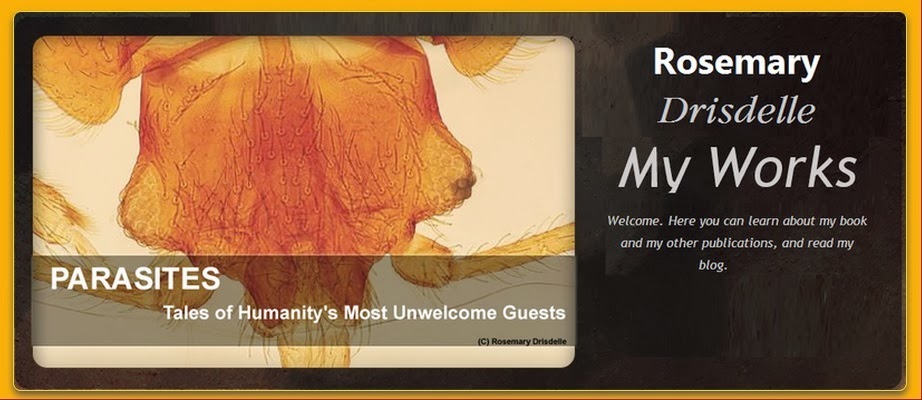 |
While it takes a blood meal, a mosquitoe might
transmit a disease-causing organism. Thankfully,
mosquitoes are not known to transmit Lyme disease.
Image: US Department of Agriculture |
We’ve known for years that Lyme disease is transmitted to humans by ticks. In Europe, it’s usually
I. ricinus, the sheep tick, and any of a group of closely related organisms:
Borrelia burgdorferi,
B. garinii, or
B. afzelii; while in my area it’s the deer tick,
Ixodes scapularis, and
B. burgdorferi. This is enough to worry about as the woods are full of deer and the deer are full of ticks. In some areas more than 30% of deer ticks carry
Borrelia, and the ticks are not fussy: they’ll jump onto deer, dogs, cats, and people without hesitation. One hates to think that other biting arthropods could also be transmitting Lyme.
But studies going back as far as the 1980s, and perhaps even farther have found
Borrelia in the guts of mosquitoes. Websites devoted to Lyme disease state that mosquitoes are transmitting the disease to humans. Why, then, does the CDC website say “There is no credible evidence that Lyme disease can be transmitted… from the bites of mosquitoes, flies, fleas, or lice” (
Lyme Disease Transmission)?
Lyme Disease Organisms (Borrelia) in Ticks
It’s not a matter of a mosquito or tick sucking
Borrelia out of one host and then simply injecting it into another like a flying (or crawling) syringe, not like pouring liquid from one glass to another with no change in the contents. Here we are dealing with interactions between living things. Research has shown that things happen in the tick, things that are important in transmission.
In the tick’s gut,
Borrelia produces a protein that enables it to persist there for long periods of time, likely aiding survival until the tick feeds again. When the tick is feeding, the spirochete cuts back on this protein and produces a different one instead, one that enables it to invade the tick’s salivary gland and then be transmitted to the new host in the tick’s saliva.
Similarly,
Borrelia is able to enhance a tick protein that protects both tick and spirochete from attack by the host immune system: “
Borrelia burgdorferi, the Lyme disease agent, is critically dependent on the presence of the tick protein Salp15 when infecting the host” (Schwalie and Schultz). The extended time that a tick spends feeding (days) provides plenty of time for this interaction to take place.
Lyme Disease Organisms (Borrelia) in Mosquitoes
In contrast, while
Borrelia has been detected in mosquito guts and saliva, it doesn’t appear to survive there very long, probably because the proteins that support it in ticks don’t work in mosquitoes. Salp15, too, is a tick protein that won’t be available to help out in a mosquito, and mosquitoes take only minutes to obtain a blood meal, compared to days for a tick. Put simply, mosquitoes are not competent vectors of
B. burgdorferi; they just don’t have the right stuff. While it’s not impossible that a mosquito bite could contain the spirochetes, it’s unlikely, and it’s even more unlikely
Borrelia would succeed in setting up an infection. Mosquitoes are not significant vectors of Lyme disease.
References
Fontaine et al: Implication of haematophagous arthropod salivary proteins in host-vector interactions.
Parasites & Vectors 2011 4:187 doi:10.1186/1756-3305-4-187
Hovius, JWR.
Tick-host-pathogen interactions in Lyme borreliosis. Dissertation, Academic Medical Center, University of Amsterdam 2009
Kosik-Bogacka D, Bukowska K, Ku?na-Grygiel W. Detection of
Borrelia burgdorferi sensu lato in mosquitoes (Culicidae) in recreational areas of the city of Szczecin.
Annals of Agricultural and Environmental Medicine 2002, 9, 55–57
Schwalie PC, Schultz J. Positive Selection in Tick Saliva Proteins of the Salp15 Family.
Journal of Molecular Evolution Volume 68, Number 2 (2009), 186-191, DOI: 10.1007/s00239-008-9194-1
Magnarelli LA, Anderson JF. Ticks and Biting Insects Infected with the Etiologic Agent of Lyme Disease,
Borrelia burgdorferi.
Journal of Clinical Microbiology Aug. 1988, p. 1482-1486






.jpg)





